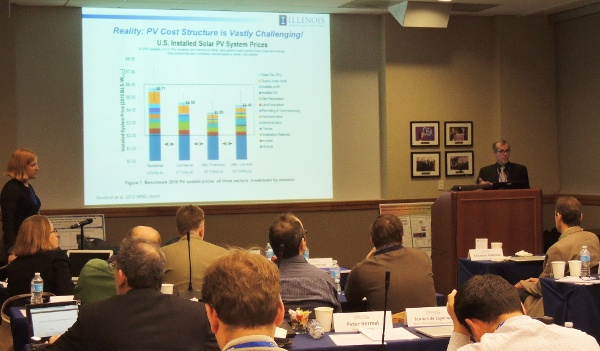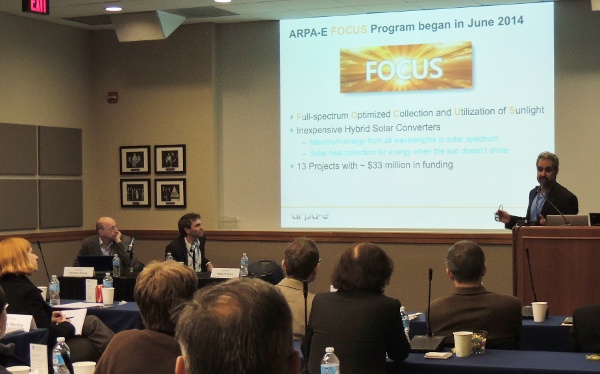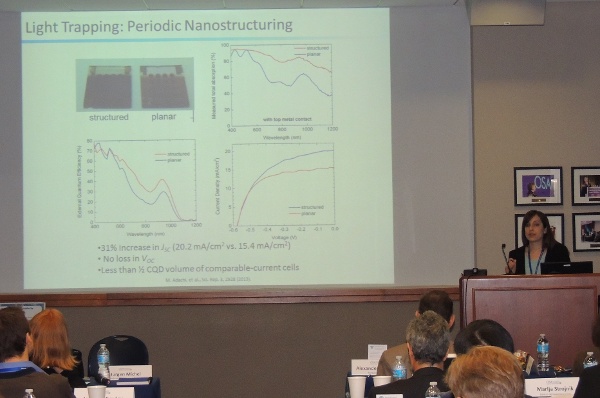Optica Blog
Developments in Optics for Energy Conversion
Jonathan Tong
In particular, multijunction solar cells were cited as the path forward in future PV systems due to its potential of high energy conversion efficiency relative to its cost. When considering the other costs affiliated with PV modules, a high efficiency would effectively lower all these costs whereas material reduction only addresses a portion, as argued by Ralph Nuzzo, who developed a micro-CPV multijunction system. Indeed, Eli Yablonovitch described how the performance of multijunction solar cells has the potential to reach even higher levels in part because of the more free energy available to photons. He described that the open-circuit voltage (Voc) will always be lower than the electronic band gap due to entropy loss. Counter-intuitively, a high efficiency solar cell thus requires a high external luminescence to maximize the Voc. He also noted that perovskites have a great deal of potential because of its high luminescent efficiency even at low excitation power; but, the inherent instability of the ions and the subsequent degradation of the material must be addressed. To further improve multijunction systems, control of internal optics is crucial in order to effectively recycle photons in each semiconductor layer as demonstrated by Myles Steiner. He showed that it is possible to incorporate spectrally selective filters through mechanical stacking of different PV modules. In addition, higher quality wide band gap III-V semiconductors are also needed to provide efficient utilization of shorter wavelength light. Of particular interest is the development of InGaP and InAlP alloys, as presented by Larry Lee, which does not require lattice matching for growth.
In an alternative scheme, Jeremy Munday discussed that it is possible to make a semiconductor to optically behave like a wider band gap material through the introduction of a photonic crystal. Although absorption is partially blocked, the simultaneous blocking of radiative emission reduces entropy loss resulting in a higher Voc. Zongfu Yu showed that this same methodology can be achieved by simply splitting a semiconductor into a thin-film and a substrate. The thin-film is an optical resonator where the cutoff of the waveguide modes can act as an effective band gap increase. He also showed that for thermal emission utilizing optical resonators exhibits band splitting in the near-field and no band splitting in the far-field with the potential of phase coherence.
There also exists a need to better understand the electrodynamics of the system and enable further optimization. However, conventional methods based on AFM scanning are confined to the surface while electron energy loss spectroscopy cannot distinguish radiative and non-radiative recombination. To overcome these limitations, a new approach based on cathodoluminescence was introduced by Ashwin Atre which involves bombarding a sample with electrons resulting in radiative emission. Using this technique, a full 3D map of an excited plasmon, as a function of wavelength, was shown for a metal dielectric crescent.
Low-dimensional material systems also offer unique material properties that can be used in solar applications. A nice review of 2D materials was presented by Volker Sorger who showed that several earth abundant materials are already available with conducting, semi-conducting, and insulating electrical properties. By stacking or rolling it there is potential in creating multijunction cells. Metasurfaces offer the potential towards unique optical properties confined to a surface. In particular, spectral splitting using a metasurface phase gradient was shown by Koray Aydin. By using a metasurface, it is possible to achieve spectral splitting with only one diffraction mode present for unpolarized light.
Quantum dot solar cells also offer a potentially low-cost and flexible approach towards solar energy conversion. Quantum dots can exhibit long hot electron lifetimes useful for hot electron extraction and multi-exciton generation, as presented by Matthew Beard. By using a core-shell composite of PbSe and CdSe in a quantum dot solar cell, it was shown that the internal quantum efficiency can exceed 100% indicating the presence of multi-exciton generation. It was also mentioned that the presence of dangling bonds, or ligands, was a primary source for recombination limiting performance. Susanna Thon discussed how in PbS quantum dot solar cells, which exhibit 8-9% energy conversion efficiency, that the transport lengths of the carriers is limited by non-radiative recombination to 300-400nm. To overcome this, she used an ultra-thin film of quantum dots to reduce the distance needed for carriers to travel to the contacts. She showed that a folded array would allow multiple reflections within the thin-film increasing its path length and likelihood for absorption.
Plasmonics also offer potential gains in solar energy conversion principally due to its ability to strongly confine light into high momentum states. Matthew Klug showed that by using core shell composites of Au and TiO2, it is possible to create nanoparticles with localized plasmon frequencies that span the visible and NIR wavelength range for use in a dye sensitized solar cell. Alternatively, Wallace Choy presented how plasmonic effects were introduced in an organic solar cell in order to redistribute and localize light in close proximity to the backside contact thus reducing the distance needed for low mobility holes to travel. In this manner, he demonstrated the ability to break the space charge limit. In another case, Jao van de Lagemaat showed that the photogeneration process can be circumvented with the direct excitation of electrons from the HOMO energy band to the acceptor state by coupling excitons with plasmons in what is known as the charge transfer process. Krysztof Kempa showed a similar process in conventional PV systems where the lifetime of hot electrons could be improved by scattering into plasmons rather than being thermalized.
The limitation of plasmonics is the dissipation of energy as heat. However, Alexander Govorov showed that plasmonic heating of metallic nanoparticles can lead to the generation of superheated water vapor when illuminated by a laser. As plasmonic heating will lead to degradation of metallic nanoparticles, such as Au and Ag, there is a need for plasmonic materials that are stable at higher temperatures. Past studies have identified several alternative materials including transparent conducting oxides and transition metal nitrides. In particular, TiN has a melting point of 2700C and exhibits optical properties similar to Au as shown by Vladamir Shalaev. Furthermore, he showed the ability to create high quality epitaxially grown thin films and single crystal nanoparticles of TiN. For TPV applications, he also showed that ultra-thin films of TiN can act as a selective emitter.
Also discussed was thermionic emission where hot electrons emit directly into free space from a hot metal to a cold metal resulting in a current. As Svetlana Boriskina demonstrated, conventional materials, such as Au, are in fact not optimal for hot electron extraction, other materials including graphite and graphene exhibit a density of states that peaks for higher energy electrons. In this case, she showed that in an ideal system, the energy conversion efficiency can reach upwards of 7-8%. Martin Cryan added that lithiated diamond emitters have a negative electron affinity, thus can easily emit electrons into free space. To provide sufficient cooling, this system was coupled to a metallic grating to again enable plasmonic heating.
The second keynote speaker for the day, Gang Chen, focused more on the fundamental limits of radiative heat transfer. In particular, he showed that in the near-field regime, it is possible to break Planck’s law by placing two surfaces in close proximity enabling evanescent modes to couple thus increasing radiative heat transfer by several orders of magnitude. From classical heat transfer, it is known that the conductance of radiative heat transfer and heat conduction differ by several orders of magnitude. Although near-field radiative heat transfer appears to describe the transition between these two regimes, the EM formulation used to describe this phenomenon diverges as the two surfaces approach contact. To correct for this, an atomistic model of an ionic solid was simulated incorporating bonding potentials and long range electromagnetic interaction. Finally, he gave an introduction to the thermodynamics of radiative heat transfer with a particular emphasis on the derivation of the Landsberg limit which describes the limit to radiative heat transfer in a Carnot heat engine.
Day one ended with a panel discussion from representatives of the DOE ARPA-E and Sunshot programs who provided an overview of their programs and their perspective on the future of solar energy. The key to solar energy is to provide sufficient dispatchability during the day and night as discussed by Howard Branz. The problem however is the lack of infrastructure to incorporate PV into the grid and cost of storage. Thermal storage offers a potential route but requires more effective utilization of the solar spectrum (i.e. spectral splitting so that a portion goes to PV and the rest goes to heating). A similar message was conveyed by Larry Tinker who noted that the key is to ultimately improve light management in these systems to better utilize the solar spectrum. Mike Haney argued that there’s “plenty of room in the middle.” Essentially, the idea is through economies of scale, the cost of PV can be brought in a similar manner to microelectrionics and microphotonics. In this way, a high power areal density and a low cost areal density can be achieved.

NAME

NAME

